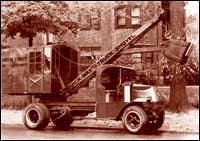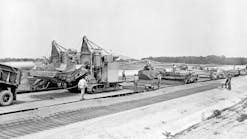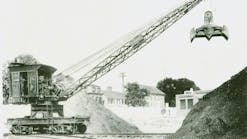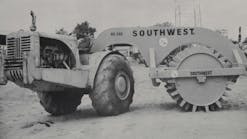The cable-operated Quick-Way handled a ½-cubic-yard bucket, and it could crane 5.5 tons at a 10-foot radius. Its mechanical clutches were operated hydraulically.
In 1919, a young engineer named Luke E. Smith was watching a crawler-mounted shovel on a road job in some of the highest mountain country in Colorado between Durango and Silverton. Noticing how slowly the shovel moved about the job, he had an idea: If he mounted a shovel on a truck, it could not only move faster on the job, it could move under its own power between jobs, resulting in more work done at the end of the day.
Smith set to work drawing up a general design for a machine. He knew it would have to be light for portability, of all-steel construction, and correctly balanced for digging. His first experiment was placing a war-surplus crane on a truck. It worked on road construction in Tensleep, Wyo., in 1922.
The Wyoming highway department was so impressed with Smith's idea that it asked him to manufacture one for the department. The machine was a partial success but needed some modifications and redesign to reach Luke's goals of ruggedness and reliability. He conferred with several engineers and continued working on the plans until 1929 when he supervised the building of the first production machine. It was America's first truck-mounted shovel, aptly named the "Quick-Way," and the Quick-Way Truck Shovel Co. was thus established in Denver.
The machine worked so well that additional Quick-Ways went into production immediately, and from 1929 to the beginning of World War II, several hundred machines were built and put into operation across the country. The cable-operated machine handled a ½-cubic-yard bucket and was basically set up as a shovel, but other attachments were added later, including hoe, clamshell, dragline and pile driver.
As a crane, it could lift 5.5 tons at a 10-foot radius. Its mechanical clutches were operated hydraulically. The base machine (upper) weighed 5.5 tons and could be mounted on any truck chassis of at least 3.5 tons capacity as specified by the customer. The machine was well balanced so that heavy counterweights were eliminated, and its makers claimed it operated on 2 gallons of gasoline per hour.
During the war, the Quick-Way Model E was thoroughly tested by the Army and Air Corps and came through with flying colors. As a result, 2,225 Quick-Ways were delivered to the government and shipped worldwide to various theaters of war. The increased machine population allowed the company to set up a distribution network for parts and service across America, and a new factory opened in Denver in 1946. After this, the line was expanded to cover sizes from ¼- to 1-cubic-yard capacity.
Quick-Way continued to supply the military with machines, including sizeable orders shipped during the Korean conflict. In 1958, the company received its largest peace-time contract: 497 heavy-duty machines in the 25-ton class supplied to the government. In 1960, Quick-Way introduced the Grademaster, a hydraulic excavator with a telescopic boom. Then in 1961, the company was sold to the Marion Power Shovel Co., which added the Grademaster to the smaller end of its extensive excavator line. The Quick-Way name disappeared.
You can read more about the evolution of construction equipment in Keith Haddock's illustrated book "The Earthmover Encyclopedia," available in most bookstores. Also, consider a membership in the Historical Construction Equipment Association, www.hcea.net.






